Let us say you are sick; you visit a doctor and he couldn’t find the reason you are sick. He suggests some tests on the basis of the symptoms you are showing.
If you have to do multiple tests like blood tests and sonography or CT scan or ECG etc. Earlier, you have to visit multiple places which causes inconvenience but is costly and time-consuming too.
With the emergence of the diagnostic center as a one-stop place, patients get the test done at one place and the doctor gets results faster and can reach the cause of their sickness.
What is a diagnostic center?
It can be said a medical facility that provides diagnostic services to other medical professionals or to the general public.
Wikipedia says A medical test is a medical procedure performed to detect, diagnose, or monitor diseases, disease processes, susceptibility, or to determine a course of treatment. Medical tests such as physical and visual exams, diagnostic imaging, genetic testing, chemical, and cellular analysis, relating to clinical chemistry and molecular diagnostics, are typically performed in a medical setting.
These tests can be performed in the diagnostic center where the right equipment and technician are available.
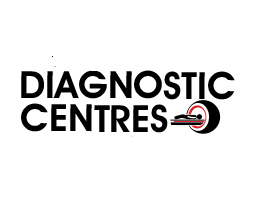
What is the role of diagnostic center?
A diagnostic center is where patients of all ages and genders are diagnosed. These facilities are outfitted with the necessary laboratory equipment and skilled workers, as well as medical personnel who aid them in the process of detecting illnesses in patients who exhibit certain symptoms or indicators.
Improved health care is associated with better medical diagnosis. It is a medically confirmed truth that diseases such as cancer, diabetes, and tumours may be efficiently cured if discovered and treated at an early stage, and in some cases even before the patient begins to display signs and symptoms of the diseases.
What is diagnostic process?
Preliminary diagnostic evaluation:
In preliminary diagnostic evaluation the doctor does the physical examination of the patient and asks about his medical history to understand at present the symptoms which he is showing has a back history with him.
Mostly doing a preliminary diagnostic evaluation always yields results as some kind of hint or indication is informed or seen by the attending physician and on the basis of that, the attending physician can form a hypothesis and come to a differential diagnosis (Differential Diagnosis means when a doctor or attending physician identifies and differentiates between two or more conditions based upon the symptoms the patient is showing).
For example, many patients call their doctor or attending physician and tell them they are having a headache. Most of the time it’s just a normal headache that will go away in some time as this can be caused by tension or constipation or migraine. But this can also be a symptom of subarachnoid hemorrhage (SAH). Its roughly 1% chance of that happening but how to confirm that is not the case.
The doctor or the attending physician will ask question to know if there is any history or family history of any kind of diseases or if this is a repeating activity. Location of the pain, severity and any other pain in the said region or near by region. Then comes the physical examination like mental status (alertness, responsiveness), head and face and oral cavity, eyes, neck, along with these neurological tests like motor, speech, visual.
This probing question will give him some idea and he will form an opinion and ask you for a diagnostic test.
Diagnostic testing:
Diagnostic testing is used to affirm the suspected diagnosis formed by the doctor or the attending physician. These tests include pathology tests like blood, urine, stool, etc, and scan-based tests like sonography, CT scan, MRI, etc.
In the above case, a CT scan was ordered to rule out SAH, and if it’s negative then either lumbar puncture will be suggested to get a clearer understanding, and if the patient refuses then consider that but inform the effects if found out later.
Consultation, treatment, and follow-up:
If the test comes positive from there the process moves forward with consultation and how the treatment will proceed and the follow-up thereafter. The things he can and can’t do and if any change he feels or resurrection of pain or other symptoms happens then to call.
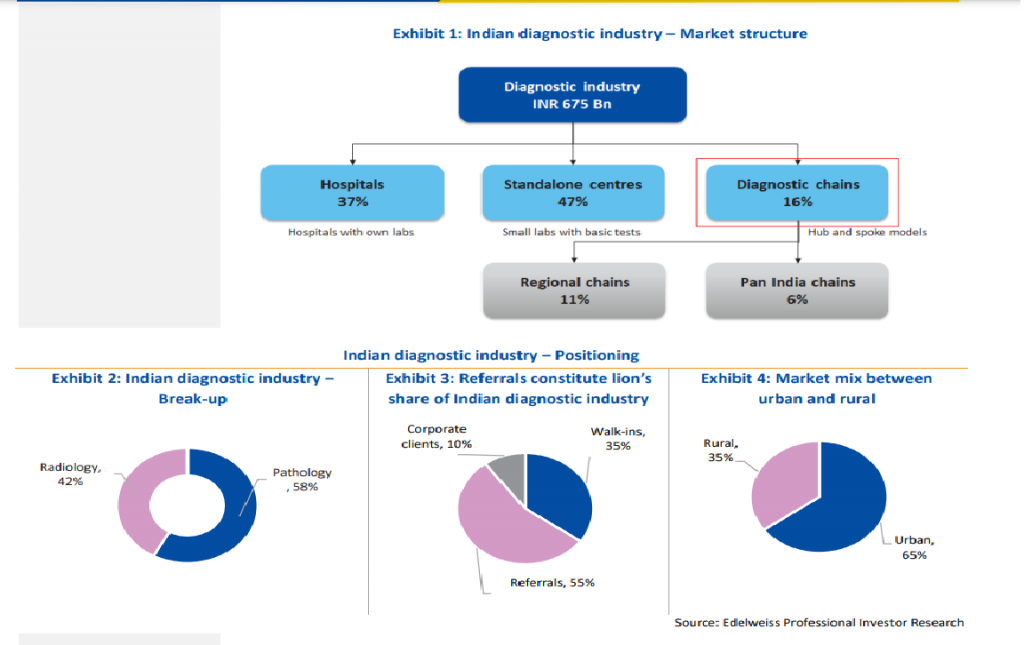
Type of diagnostic test
Before going into the different types of the diagnostic test, let us learn about types of diagnosis. There are two types of diagnosis and they are
- Clinical-based diagnosis. This diagnosis is made on the basis of reported symptoms, and medical signs rather than diagnostic tests. The knowledge or information got from the patient and further physical examination will lead us to come to a diagnosis.
- Laboratory-based diagnosis. This diagnosis is made significantly on laboratory reports or test results, rather than the physical examination of the patient. The testing of blood, urine, and other bodily substances to understand the condition of the patient and come to a diagnosis.
Now let us understand the diagnostic test. We can base this on two types.
Image-based diagnostic testing procedure (in vivo diagnostics):
Sonography or Ultrasound:
Using transducer to send sound waves to get the image on the computer and get and print of the same for reference later. This is one of the non-invasive procedures and usually, the abdomen and pelvic area are covered in this.
The high-frequency sound waves are bounced on the targeting area to get the image. In this procedure the area where sonography needs to be done, the gel is applied which assists in getting a clearer picture.
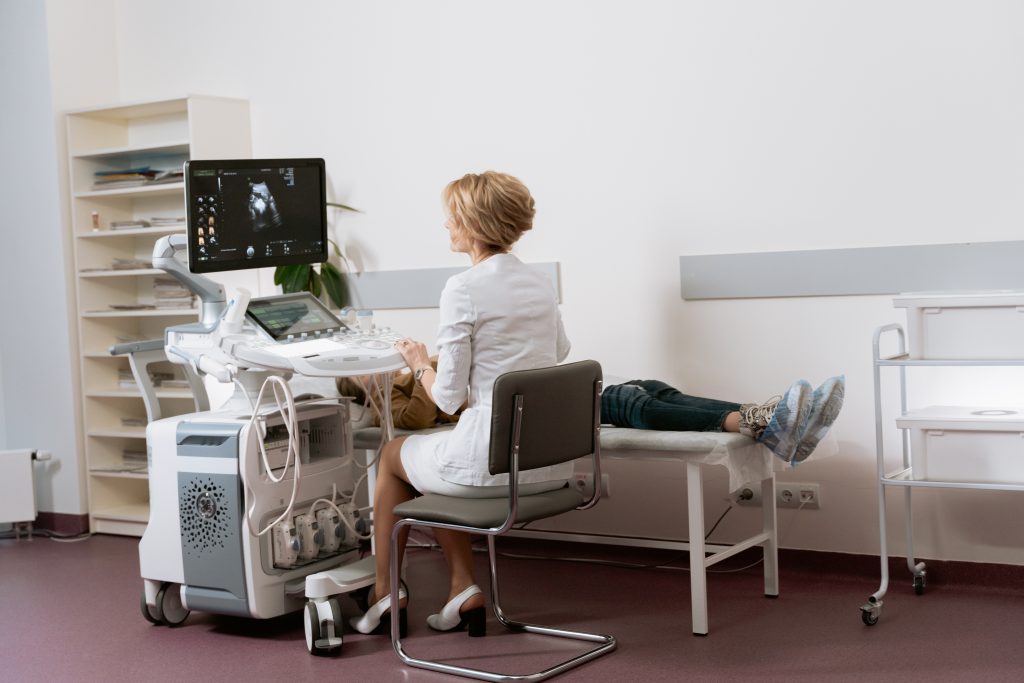
The high use to sonography to identify child sex in pregnant women and due to child abortion is high so identifying child sex is ill legal other than that it not ill legal.
To learn more about sonography, you can read “What is Sonography Test – The result of Ultrasound”
2D Echo or Echocardiography
2D Echo or 2D Echocardiography is a non-invasive method to investigate and evaluate the function and condition of any section of the heart by creating various images of the parts of the heart which need to be investigated by using sound vibration which assists in checking any blockage, damage, and blood flow rate. The 2D Echo test is routinely used for diagnosis, management, and follow-up of patients suspected of heart diseases.
A 2D Echo test is similar to an ultrasound test. The chest is uncovered and colorless gel is applied to the area and technician instructs the patient to lay on the table on his left side and by using a transducer to move across different or specific parts of the chest to get an image on the computer and can be printed or stored on the hard drive like DVD or memory sticks.
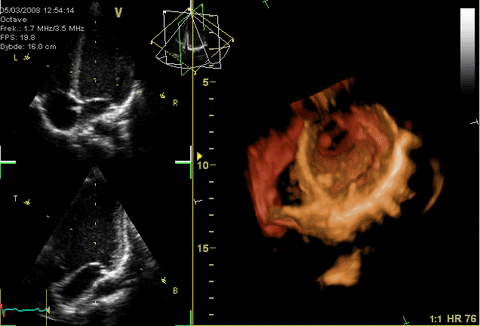
After the test is over the gel is wiped off the patient and he can redress after that. Normally the procedure will be over within half to an hour and this procedure is performed in front of a cardiologist and of a radiologist. This is a safe procedure and not a painful one either and is still used widely.
To learn more about 2D Echo or Echocardiography you can read “What is 2D Echo Test -The Beginners Guild”
X-Ray
X-rays are a form of electromagnetic wave radiation in which images of the interior of your body are created using X-ray imaging. The photos depict various sections of your body in various colors of black and white. The image is formed due to the fact that various tissues absorb varying quantities of radiation. Calcium in your bones absorbs the most x-rays so the bones appear white. Fat and other soft tissues absorb less and appear grey as a result. Because air absorbs the least, the lungs appear black.
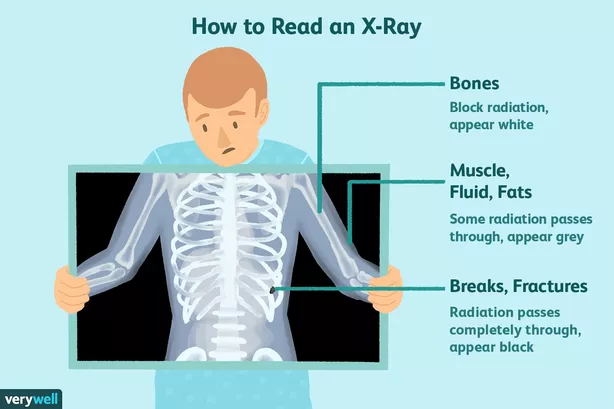
The most common application of x-rays is to look for fractures (broken bones), although they are also used for other purposes. for example, Chest x-rays detect pneumonia also. Mammograms employ x-rays to detect breast cancer.
To safeguard particular sections of your body during an x-ray, you may be required to wear a lead apron. The quantity of radiation emitted by an x-ray is negligible. A chest x-ray, for example, emits a radiation dosage compared to the amount of radiation you are naturally exposed to from the environment over a 10-day period.
CT scan
A computed tomography (CT) scan combines a series of X-ray pictures collected from various angles throughout your body and utilizes computer processing to generate cross-sectional images (slices) of your bones, blood arteries, and soft tissues. CT scan pictures include more information than standard X-rays.
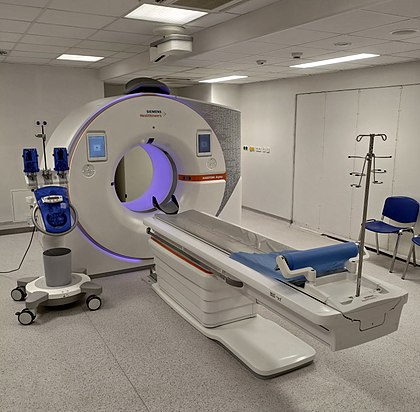
A CT scan has various applications, but it’s especially useful for immediately examining patients who may have internal injuries from automobile accidents or other sorts of trauma. A CT scan can view nearly every area of the body and is used to diagnose sickness or damage as well as plan medical, surgical, or radiation therapy. CT scan give better details than X-ray and between CT scan and MRI, CT scan is faster but MRI helps in getting highly detailed image to help the doctor.
MRI (Magnetic Resonance Imaging)
Magnetic resonance imaging (MRI) is a medical imaging procedure that creates detailed pictures of your body’s organs and tissues by using a magnetic field and computer-generated radio waves.
The majority of MRI devices are made up of huge, tube-shaped magnets. When you lie inside an MRI machine, the magnetic field realigns the water molecules in your body for a brief period of time. Radio waves cause these aligned atoms to emit feeble signals, which are then utilised to generate cross-sectional MRI pictures, similar to slices in a loaf of bread.
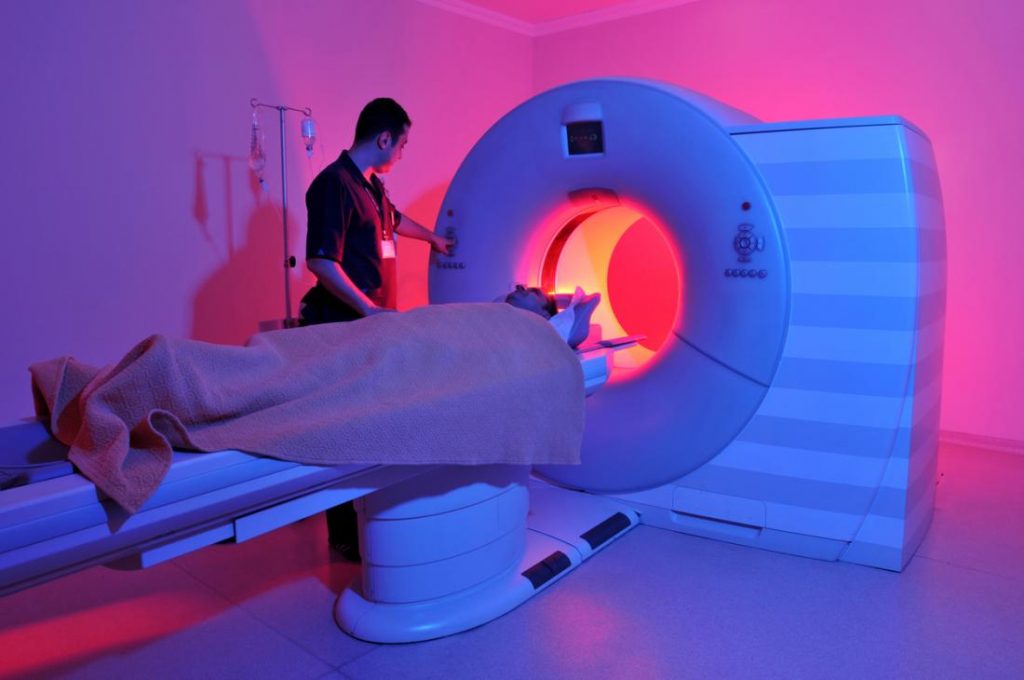
Mammogram
Mammograms are X-ray images of your breasts. It can be used to screen for breast cancer or for diagnostic purposes, such as investigating symptoms or odd results on another imaging test.
Your breasts are squeezed between two hard surfaces during mammography to spread out the breast tissue. The pictures are then captured in black-and-white by an X-ray machine and inspected for symptoms of cancer on a computer screen.
Mammograms are essential for breast cancer screening. They are capable of detecting breast cancer before it creates symptoms. Breast cancer screening mammograms have been demonstrated to minimize the chance of death from the disease.
Sample-based diagnostic testing (In vitro diagnostic):
In sample-based diagnostic testing, the test is done on a sample like bodily fluids or tissues, or blood or we can say biochemical, pathological, and microbiological tests.
Liquid biopsy
A liquid biopsy, also known as a fluid biopsy or fluid phase biopsy, is the collection and examination of non-solid biological matter, most often blood. This sort of method, like a conventional biopsy, is primarily utilized as a diagnostic and monitoring tool for illnesses such as cancer, with the added benefit of being largely non-invasive.
By obtaining repeated samples over a few weeks, liquid biopsies may also be used to confirm the efficacy of a cancer therapy medicine. After therapy, the technology may potentially be useful for patients to monitor recurrence.
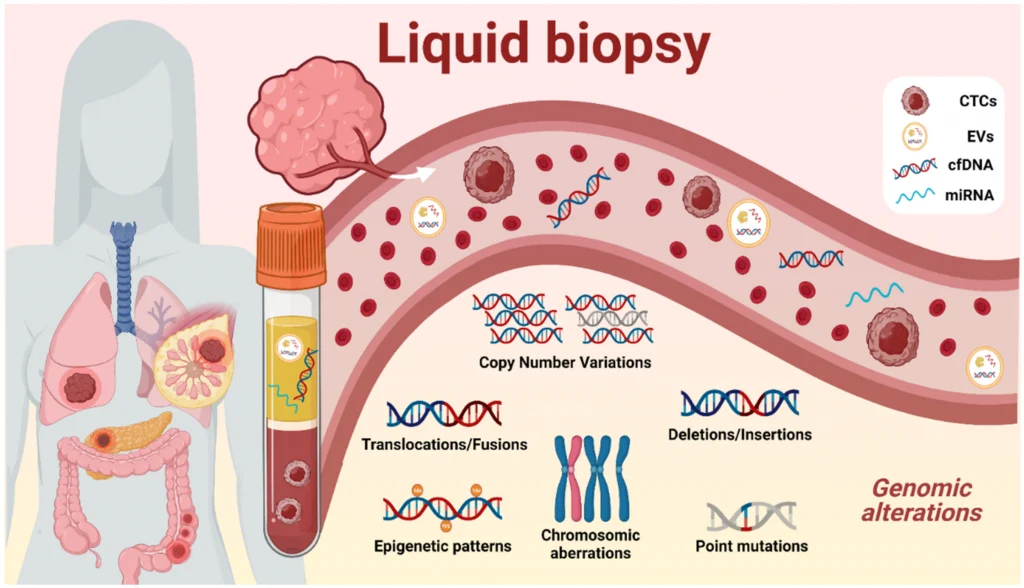
Microbiological Culture
A microbiological culture, also known as a microbial culture, is a method of multiplying microbial organisms in a controlled laboratory setting by allowing them to reproduce in a predetermined culture medium. Microbial cultures are important diagnostic tools in molecular biology research.
Microbial cultures are used to determine the kind of organism, the number of organisms present in the sample being studied, or both. It is an important diagnostic method in microbiology that allows the agent to grow in a particular media to detect the aetiology of infectious disease. For example, a throat culture is acquired by scraping the lining of the throat and blotting the sample into a medium to screen for hazardous bacteria like Streptococcus pyogenes, the causative agent of strep throat.

In addition, the term culture is more widely used colloquially to refer to “selectively cultivating” a certain type of microorganism in a laboratory environment.
Genetic testing
Genetic testing, often known as DNA testing, is used to detect changes in DNA sequence or chromosomal structure. Measurement of the effects of genetic changes, such as RNA analysis as an output of gene expression or biochemical analysis to measure specific protein synthesis, can also be included in genetic testing. In the medical setting, genetic testing can be used to diagnose or rule out suspected hereditary disorders, assess risks for certain conditions, or collect data that can be used to change medical treatments depending on an individual’s genetic makeup.
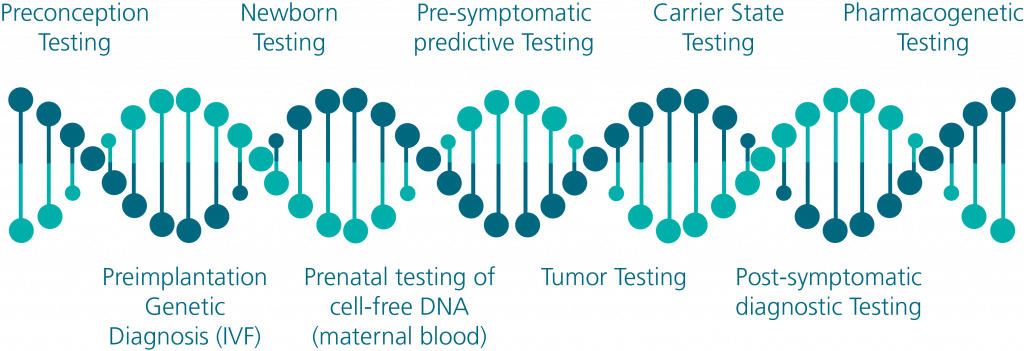
Blood sugar level or Glycaemia
Blood glucose level is the concentration of glucose in the blood of humans or other animals. At any one time, a 70 kg (154 lb) person has around 4 grammes of glucose, a simple sugar, in his blood. The body rigorously manages blood glucose levels as part of metabolic homeostasis. Glucose is stored as glycogen in muscle and liver cells; in fasting individuals, blood glucose is kept constant at the expense of glycogen stores in the liver and muscle.
A continuous increase in blood glucose levels generates glucose toxicity, which leads to cell dysfunction and the pathology known as diabetes complications. Glucose may be transferred from the intestines or liver to other tissues in the body via circulation. Insulin, a hormone produced in the pancreas, is primarily in charge of regulating cellular glucose absorption.
Glucose levels are normally lowest in the morning, before the first meal of the day, and rise by a few millimoles for an hour or two following meals. Blood sugar levels that are greater than normal may indicate a medical concern. A persistently high level is known as hyperglycemia, and a persistently low level is known as hypoglycemia. Diabetes is the most prevalent condition linked with blood sugar control failure and is defined by persistent hyperglycemia induced by one of several reasons. Blood tests are done in pathology which is a part of the diagnostic center.
Liver function test
Liver function tests (LFTs or LFs), often known as a hepatic panel, are groups of blood tests that provide information on the health of a patient’s liver. Among them are prothrombin time (PT/INR), activated partial thromboplastin time (aPTT), albumin, bilirubin (direct and indirect), and other tests. Most liver illnesses have minimal symptoms at first, but these diseases must be identified as soon as possible. The involvement of the hepatic (liver) system in many illnesses might be significant like diabetes.
There are many more tests like testing for electrolytes in the blood such as sodium, creatinine, urea. Apart from blood samples, urine, stool, and sputum samples are also checked to find out the condition of the patient and related diseases.
What is the benefit of diagnostic testing?
Protecting the patient
Life of a patient is saved or not, prolonged or cut short is many times comes to how fast your diagnosis is confirmed and it depends upon the diagnostic test and its result. Early diagnosis helps to minimize the severity of the disease.
Improving patient care
Once the diseases is confirmed treatment can be made to the exact condition to suit the patient need and further provide more patient care. Subsequent medication is also depending upon further test result and the effect of the medication can be changed or dosage can be increased or decreased based on the test result.
Reduce healthcare spending
If your doctor or attending physician could not find what is making you sick and you keep going to him time after time and the medicine you are purchasing for immediate relief but not permanent, that means you are not getting cured but keep on spending on your health. But if you can detect what is wrong at an earlier stage and get a remedial treatment that would not only reduce your cost on the health care but will also reduce the hassle you face and the tension will be less also get a better quality of life.
Future of Diagnostic center.
The onset of numerous health issues was increased manyfold by the global epidemic. The world is still dealing with the aftereffects of this devastating disease, as well as a myriad of other difficult health issues. Opportunities for innovators, entrepreneurs, researchers, and industry to collaborate to co-create an advanced diagnostic sector and breakthrough healthcare technologies abound as we prepare for the future. Adopting an open innovation strategy can assist healthcare practitioners in reaching a bigger population.
The healthcare industry as a whole has recognized that healthcare has expanded outside the four walls of a hospital and has become more agile. The growth of home health testing also allows patients to complete the whole health management sequence from home, from blood tests to prescription administration via teleconsultation with doctors. A full ecology in and of itself. In the future, people would most likely only visit a lab for complex and specialized testing.
Getting fast results for medical conditions is paramount now. An analytical approach towards health itself is getting fast recognition not only with health professionals but with patients. Patients now want to know more about the disease they are suffering the cause and the effect of it and for all this, a technological-led diagnostic is needed. Moreover, due to automation the reports and all the findings can be stored digitally and can be shared across the world where experts are and get their options on the symptoms and diagnosis.
With technology, in general, is getting updated and innovation is making the equipment small and intelligent and with AI and big data analysis coming into the picture past cases can be referred, symptoms being analyzed with previous cases and current cases if any, and looking at test reports taken with advanced machines giving clearer picture and results and in-depth too. The future of diagnostic seems bright as the sun and moving towards an upward trajectory.
Conclusion
To corelate between the symptoms and the disease and to treatment and from treatment to progress of treatment and confirmation of cure of the disease, diagnostic test and diagnostic centre play a vital role. With the widespread diagnostic centre available to the patient, they can get their pick of choice and get the best place to get tested and to move forward.
Though diagnostic center is an unorganized sector and highly fragmented along with under-penetrated industry. It is said only Indian diagnostic industry is estimated to be USD 9 Bn (INR 675 Bn) and will be growing at 10% CAGR. With diagnostic center has a market share of 47% alongside hospital and diagnostic center chains having 37% & 16%.
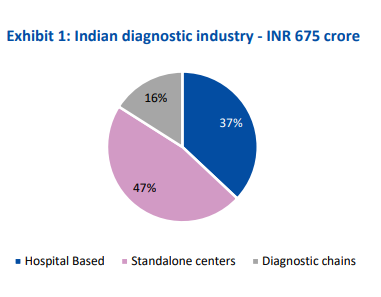
With time the systems will be getting better and knowledge about medical science and equipment will also get better and the patient will get faster and more accurate results so that the treatment that is planned for them will be more effective to cure the disease and cost-effective too as time and money is spend on find the reason of sickness.
Diagnostic centers are playing an important part in providing better healthcare for the general population and with more spread of them with quality people and advanced equipment, the result will be more effective to the health industry as a whole.
Is MLT a doctor?
Medical lab technicians are healthcare professionals who work alongside physicians but are not physicians themselves. A medical technician can become a doctor by attending medical school and completing their studies in their chosen field.
Medical lab technicians play a vital role in hospitals and physicians’ offices. These specialists are an important part of every well-functioning healthcare facility. They perform lab tests on specimens under the direction of physicians, lab managers, or lab technicians. Their work behind the scenes assists doctors in detecting diseases or illnesses and determining treatment alternatives.
What is a full body check-up?
A full body check-up is a comprehensive health check-up or diagnostic scan of your entire body, including your heart, kidneys, liver, and lungs, to assess your present health and screen you to see if you have any visible warning signs or if there are any abnormalities inside your body. A health exam can detect early warning indications of severe diseases such as cardiovascular disease, pulmonary disease, cancer, diabetes, high blood pressure, digestive problems, and so on.
What are diagnostic tests?
Diagnostic tests are tests used to confirm which disease is the patient is suffering from or to rule out which diseases the patient is not suffering. Before starting any treatment attending physician or doctor needs to confirm what disease the patient is suffering and according to that confirmation, he needs to plan the treatment.


4 thoughts on “What is a diagnostic center: The Essential Guide”
Pingback: what is an MRI scan
Pingback: what is a CT scan
Pingback: An Introduction to what is an x-ray
Pingback: what is a blood test